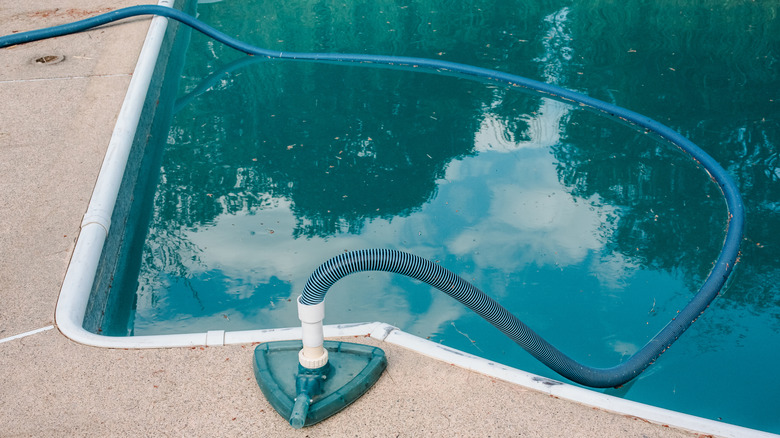The Alternative Method For Draining Your Pool Using A Vacuum Pump
There's a lot more to draining a pool than meets the eye. Not only are there concerns over proper water disposal, but emptying a pool also puts the structure itself at risk. That's because many pool materials, such as Fiberglass and vinyl linings, rely on the pool water to maintain their shape and quality and can crack or warp without it. Draining a pool should always be done carefully and only as a last resort. Besides, most pools should only need to be fully drained every five to seven years to ensure water quality, barring repairs. Whether you need to lower the water level to winterize your above-ground pool or you need to drain your pool for repairs, using a submersible pump is the best option for draining your pool, whether it's inground or above-ground.
But what can you do if you don't have a submersible pump? Jimmie Meece, president of America's Swimming Pool Company, spoke exclusively with House Digest about alternative methods. With locations across the country, America's Swimming Pool Company offers comprehensive pool services, including everything from installations and remodels to maintenance and repairs. Jimmie says that other options to drain your pool are only temporary solutions and not a permanent replacement for using the proper equipment. "Using a vacuum pump can be a temporary solution to drain your pool," Jimmie says, but he warns you should proceed with caution. "Vacuum pumps are not designed for draining pools and can be damaged in the process." If you need to use a vacuum pump as a temporary solution, there are some important steps to follow to make sure everything flows smoothly.
How to use a vacuum pump to drain your pool
Speaking exclusively with House Digest, Jimmie outlines the process of draining your pool using a vacuum pump. First, he advises gathering a few supplies: a garden hose, Teflon tape, hose clamps, and the vacuum pump (like this 2.5 CFM Vacuum Pump from Harbor Freight). Next, you'll need to seal the pump by covering the outlet threads with Teflon tape and using hose clamps to securely attach the garden hose to the pump. These steps will prevent leaks and ensure the pump properly drains the pool. Before you turn on the pump, Jimmie suggests prepping the drainage area to ensure proper water disposal. "Place the other end of the hose in a suitable drainage location — ideally a sanitary sewer or a well-draining area far from structures or landscaping," Jimmie says. "Avoid storm drains, as draining into them may violate local codes. Always check with your local water authority before proceeding."
With everything in place, it's time to prime the vacuum pump by submerging it underwater, turning it on, and letting it run on a low speed until water begins to flow steadily out of the hose into the drainage area. "Once primed, increase the pump speed (if adjustable) and monitor the process closely to ensure the hose remains secure and leak-free," Jimmie says. As the water level drops, he suggests cleaning the pool floor using a manual pool vacuum so you'll have a fresh pool to refill.
Mistakes to avoid when using a vacuum pump
If you need to drain your pool using a vacuum pump, there are a few mistakes to avoid to protect both the pool and the pump. Speaking exclusively with House Digest, Jimmie explains that the biggest risk comes from draining the pool too quickly. "Rapid drainage can cause structural damage, including cracks or even the pool lifting due to hydrostatic pressure," he says, referring to the pressure from the groundwater surrounding your pool. Draining slowly is a must to maintain the integrity of the pool while also preventing the pump from overheating.
Another mistake to avoid is improper water disposal, which can harm your home's foundation, among other problems. "Proper disposal of pool water is essential to protect the environment," Jimmie says. "The best option is to drain into a sanitary sewer system, not a storm drain, since pool water may contain chlorine and other chemicals that harm local waterways." He adds that the water should always be balanced and dechlorinated before removal. Check with your local authorities for their water disposal guidelines.
In addition to a vacuum pump, you can also siphon the water out, especially with an above-ground pool. If you are draining a spa or just need to clear out the last few inches in a pool, a wet/dry shop vacuum can get the job done. Still, Jimmie says there is no substitute for a submersible utility pump or a pool cover pump when you need to drain a considerable amount of water. "These are built to handle large volumes of water and are safer for both your equipment and your pool," he says.


